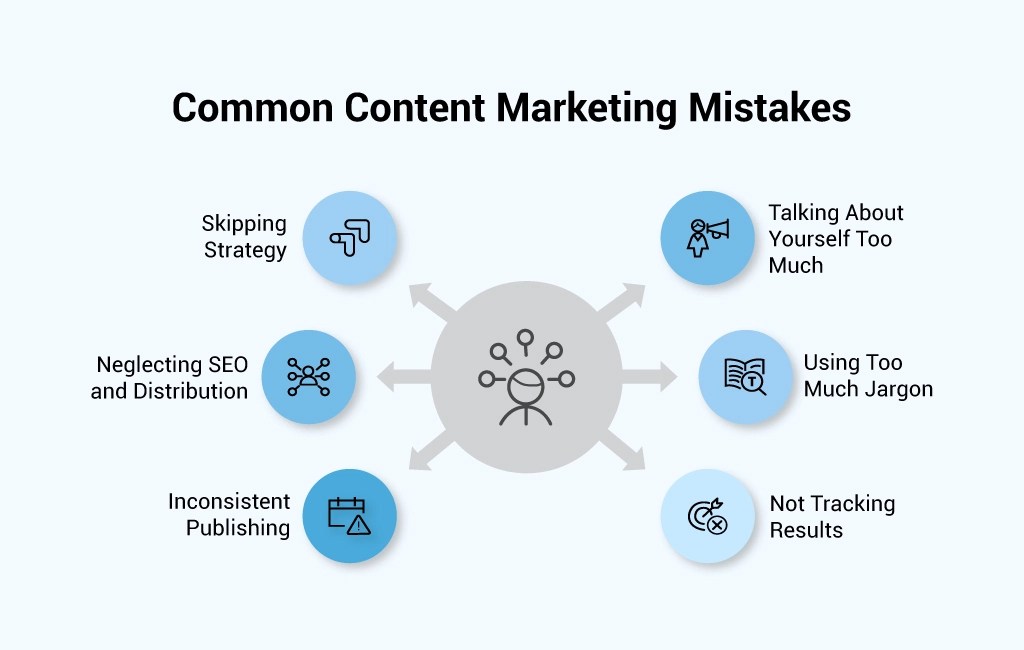Nowadays, manufacturing isn’t exactly the first industry people think of when they hear “content marketing.” But that’s exactly why it works so well.
While your competitors are still relying on cold calls, trade shows, and word-of-mouth, you could be building an online presence that speaks directly to engineers, procurement teams, and distributors long before they are ready to buy.
The truth is, B2B buyers now do most of their research online, and they are looking for proof that you understand their problems better than anyone else.
This is where strategic content marketing for manufacturers comes in, turning your website from a static brochure into a lead-generating machine.
Want to know in detail? Keep reading!
Why Content Marketing is Essential for Manufacturers
Buyers now expect to find detailed, useful, and trustworthy information online before even reaching out. Manufacturing content marketing is how you meet that expectation, while positioning your business as an industry leader and driving high-quality B2B leads. Here’s why it’s a complete game-changer:

You Show Up Where Buyers Are Searching
Most B2B buyers start their journey with an online search. Meaning, with the right content, optimized for the terms your prospects use, you are not just visible but at the same time will be positioned as a trusted solution provider right from the start.
You Build Trust Before the First Call
Manufacturing sales often involve long decision-making processes. For example, sharing technical white papers, process explainers, and real-world case studies helps prospects see that you understand their challenges and have proven results to back it up.
You Stand Out in a Crowded Market
Many manufacturers still rely heavily on trade shows, cold outreach, and word-of-mouth. And by enabling manufacturing digital marketing, you demonstrate innovation, professionalism, and an understanding of how modern buyers operate.
You Shorten the Sales Cycle
When potential customers already know who you are, what you do, and how you solve problems, thanks to your content, they are more prepared to move forward, reducing the back-and-forth and speeding up the path to purchase.
You Create a 24/7 Sales Asset
A great piece of content marketing for manufacturers works long after it’s published. Whether it’s a detailed blog post, an instructional video, or a downloadable guide, it continues to attract and convert leads around the clock without additional cost.
You Educate and Pre-Qualify Prospects
Not every lead is a good lead. Content allows you to answer common questions, set expectations, and filter out unqualified prospects, so your sales team spends more time with buyers who are truly ready to work with you.
Bottom line? Content marketing for manufacturers is about strategically building a digital presence that meets buyers where they are, earns their trust, and makes it easy for them to choose you over the competition.
Understanding the Manufacturing Buyer Journey
If you want your manufacturing digital marketing to work, you can’t just push out content and hope it lands. You need to understand exactly how your buyers make decisions and spoiler alert: it’s rarely a quick, one-step process.

After all, in manufacturing, sales rarely happen overnight. The B2B buyer journey can stretch over weeks or even months because the stakes are high, the investments are significant, and the products or services are often highly technical. That’s why having a clear idea of how your buyers move from awareness to decision is essential if you want your marketing to truly connect.
Besides, the manufacturing sales process is unique compared to other industries. Several individuals are often involved in making a purchase, such as engineers, procurement teams, quality managers, and sometimes even the C-suite. Each plays a role in evaluating your capabilities, checking technical specs, and assessing whether you are the right fit.
From a manufacturing procurement process perspective, buyers usually follow a structured path:
- Awareness – They identify a problem or need and start researching solutions.
- Consideration – They compare suppliers, evaluate technical details, and weigh pros and cons.
- Decision – They select a vendor based on capability, trust, and alignment with their requirements.
A thorough manufacturing customer journey analysis helps you pinpoint what information, content, or reassurance buyers need at each of these stages. Maybe it’s a technical white paper during the consideration phase, or a behind-the-scenes process video to build trust in the awareness phase.
The goal is to deliver the right message at the right time, so you are not just part of their journey, instead, you are guiding it.
When you understand this journey, your marketing starts feeling like a tailored experience for your targeted customer, making it far more likely they will choose you over the competition.
Top Performing Content Types for Manufacturers
As always, the best-performing content types go beyond flashy marketing, they educate, build trust, and position your business as an industry authority.
Here are three formats that consistently deliver results:
Manufacturing Email Marketing
First of all, don’t underestimate the power of the inbox. Well-crafted email campaigns let you nurture relationships over time, share industry insights, and keep your company top-of-mind with prospects.
From monthly newsletters with technical tips to targeted drip sequences for specific products, manufacturing email marketing turns casual interest into serious inquiries.

Manufacturing Webinars
Webinars are the perfect platform to showcase expertise in real time. Whether you are explaining new industry regulations, demonstrating complex processes, or sharing case studies, manufacturing webinars give you a direct line to decision-makers.
They also create opportunities for live Q&A, which can address objections on the spot and move leads further down the sales funnel.
Manufacturing Video Content
A good video can bring your capabilities to life in a way text can’t. Be it a factory tour, a process walkthrough, or a customer success story, manufacturing video content gives prospects a tangible sense of your quality and professionalism.
Plus, video is highly shareable, making it ideal for boosting visibility across your website, LinkedIn, and trade publication channels.
How to Build a Manufacturing Content Strategy?
Jumping into content creation without a plan is like starting a production run without blueprints, you might get something, but it probably won’t fit the specifications. The same goes for digital marketing in manufacturing!
If you want consistent results, you need a clear, step-by-step approach. That’s where content marketing for manufacturers strategies come in.
So, let’s take a quick look at how to build a strategy that actually works:
Define Your Target Audience
Identify exactly who you are trying to reach, procurement managers, engineers, distributors, or C-suite decision-makers.
The more you understand their needs, challenges, and buying triggers, the more relevant your content will be.
Map the Buyer Journey
Once you know who you are targeting, break down the stages your prospects go through, from awareness to decision and determine what content fits each step.
White papers and industry insights might work early on, while case studies and ROI calculators seal the deal later.
Choose Your Core Content Formats
With your audience and buyer journey mapped, the next step is deciding which content types will best communicate your expertise.

Technical Blog Posts – Drive organic search traffic and answer niche industry questions.
White Papers & E-Books – Provide in-depth insights that position you as a thought leader.
Video Content – Showcase processes, quality standards, and real-life applications.
Webinars & Live Demos – Offer interactive learning opportunities and address objections in real time.
A balanced content marketing for manufacturers mix ensures you reach both technical and executive audiences effectively.
Create a Content Calendar
Random publishing leads to inconsistent visibility. Develop a 3–6 month editorial calendar that includes:
- Topics mapped to each buyer journey stage
- Formats tailored to audience preferences
- Distribution channels for maximum reach (LinkedIn, industry forums, email campaigns)
This calendar ensures your content marketing for manufacturers stays consistent, even during peak production periods.
Optimize for Search and Distribution
Even the most insightful content will underperform if no one can find it. Search engine optimization should be part of every piece of content you create, from keyword targeting and meta descriptions to image optimization and internal linking.
To amplify reach:
Implement SEO best practices (keyword targeting, meta descriptions, and optimized titles).
Use LinkedIn and YouTube for professional visibility.
Repurpose high-performing assets (turn a webinar into blog snippets, an infographic, and a short video series).
Track, Measure, and Improve
A strategy is only as strong as the results you can measure and in content marketing for manufacturers, this means monitoring lead quality to ensure you are attracting decision-makers in your target industries rather than unqualified traffic. Hence, make sure to monitor the following things:
- Lead quality (are they in your target industries?)
- Engagement metrics (time on page, downloads, click-through rates)
- Sales cycle impact (is your content speeding up decisions?)
You can also use analytics tools and CRM data to determine which parts of your content marketing for manufacturers are delivering the highest ROI and need to double down on those efforts.
Content Promotion Channels that Work
Even the most brilliant piece of content won’t deliver results if it sits quietly on your website, waiting to be discovered.
In manufacturing, promotion is just as important as creation because the right visibility can turn a single article, video, or case study into a steady flow of leads.

To make the most of your efforts, you need to tap into proven channels for B2B content distribution. Here are some that work especially well for content marketing for manufacturers:
Manufacturing Trade Publications
Industry magazines and online trade portals are goldmines for reaching highly targeted audiences.
Publishing articles, advertorials, or sponsored content in these outlets puts your expertise in front of decision-makers who are already looking for solutions like yours.
Manufacturing Social Media
Platforms like LinkedIn, YouTube, and even niche forums can be powerful tools for connecting with engineers, procurement teams, and industry influencers.
Hence, make sure to share behind-the-scenes videos, technical tips, and customer success stories to engage your professional network.
Social Media Marketing for Manufacturers
It’s not just about posting content, it’s also about using paid targeting to get it in front of the right eyes.
LinkedIn ads, sponsored posts, and retargeting campaigns ensure your content reaches qualified prospects instead of getting lost in the feed.
Email Campaigns and Newsletters
A well-segmented email list lets you send your best content directly to prospects, clients, and partners, keeping you top of mind between sales calls or contract renewals.
Partnerships and Collaborations
Lorem ipsum dolor sit amet, consectetur adipiscing elit. Ut elit tellus, luctus nec ullamcorper mattis, pulvinar dapibus leo.
Work with distributors, industry associations, or complementary manufacturers to co-promote content. This expands your reach and lends additional credibility to your brand.
Here, the key is to match the channel with the audience and the content type. For example, a technical white paper might shine in a trade publication, while a short process video could gain traction on LinkedIn. With the right mix, your content won’t just be created, it will be seen, shared, and acted upon.
How to Measure Success in Content Marketing for Manufacturers?
Publishing content is only half the job, instead, the real magic happens when you track, analyze, and refine your efforts. In manufacturing, where sales cycles can be long and complex, you need clear data to prove your strategy is working. That’s where B2B content analytics and focused measurement come in.
The right manufacturing marketing metrics will tell you not just how many people saw your content, but whether it’s attracting the right kind of prospects and moving them closer to a purchase. Instead of relying on vanity numbers like page views alone, you should focus on KPIs that align with your sales goals. Here’s what to track:
Lead Quality and Volume – Are you attracting decision-makers in your target industries, or just general traffic?
Engagement Rates – Time on page, click-through rates, and social shares show how much value your audience gets from your content.
Conversion Rates – How many visitors download a white paper, request a quote, or sign up for a webinar?
Sales Cycle Impact – Is your content shortening the buying process by answering questions earlier?
Customer Retention and Upsell Opportunities – Are existing clients engaging with your content, leading to repeat business?
When it comes to manufacturing ROI measurement, you want to connect the dots between content and actual revenue. Tools like CRM integrations, marketing automation platforms, and analytics dashboards can show you which blog post, video, or case study influenced a sale, helping you double down on what works.
Mistakes to Avoid in Manufacturing Content Marketing
Content marketing for manufacturers can be a powerful growth engine, but only if you avoid the pitfalls that waste time, budget, and opportunities.
The truth is, many manufacturers approach content the same way they approach a production run: get it out the door and move on.
The problem? Without strategy and precision, your content won’t deliver the results you are looking for.
Below is a list of some common mistakes to watch out for:

- Skipping the Strategy Stage: Creating blogs, videos, or white papers without a clear plan often leads to random, disconnected content that doesn’t move prospects closer to a sale.
- Talking About Yourself Too Much: Yes, your capabilities are impressive but buyers care more about how you solve their problems. Content should focus on your audience’s needs, not just your own achievements.
- Neglecting SEO and Distribution: Even the most well-crafted technical guide won’t perform if no one can find it. Ignoring SEO or failing to share content across the right channels limits its impact.
- Using Too Much Jargon: While technical accuracy is important, overly complex language can turn off potential buyers, especially those outside the engineering team.
Inconsistent Publishing: Posting occasionally or going silent for months makes it hard to build trust and stay top-of-mind with prospects. - Not Tracking Results: Without measuring performance, you can’t know what’s working and what’s not, meaning you might be investing in content that’s producing zero ROI.
Avoiding these missteps means you can focus your energy on content that actually attracts qualified leads, strengthens your authority, and supports your sales team’s efforts.
Concluding Words
Manufacturing buyers don’t make decisions on flash, instead, they make them based on facts, expertise, and proof you can deliver.
That’s why, when done right, content marketing for manufacturers becomes your most persuasive sales asset, working 24/7 to answer questions, address concerns, and build confidence.
Every blog post, white paper, and customer success story becomes a strategic touchpoint that moves prospects closer to a “yes.” Therefore, start investing in that trust today, and you will soon shift from chasing leads to consistently attracting the right ones.








